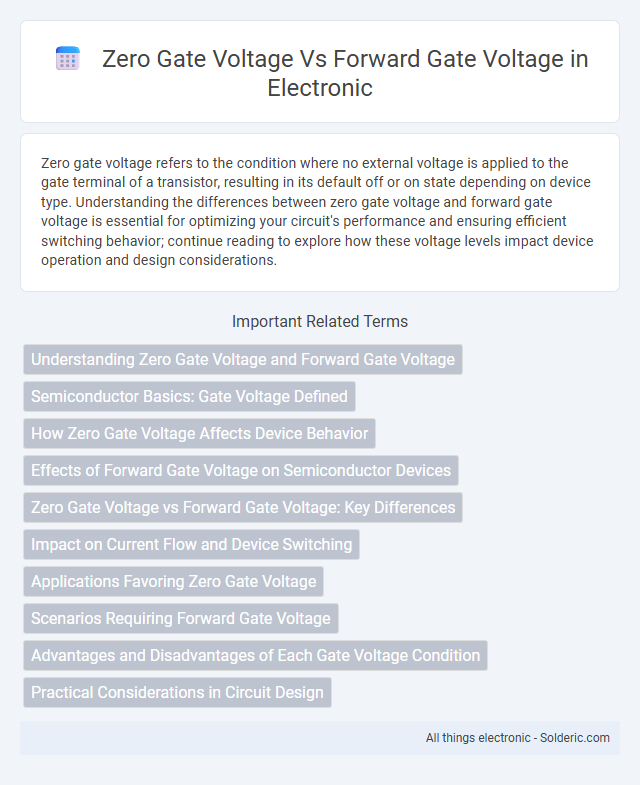Zero gate voltage refers to the condition where no external voltage is applied to the gate terminal of a transistor, resulting in its default off or on state depending on device type. Understanding the differences between zero gate voltage and forward gate voltage is essential for optimizing your circuit's performance and ensuring efficient switching behavior; continue reading to explore how these voltage levels impact device operation and design considerations.
Comparison Table
| Feature | Zero Gate Voltage | Forward Gate Voltage |
|---|---|---|
| Definition | No external voltage applied to the gate terminal. | Positive voltage applied to the gate terminal relative to the source. |
| Device Operation | Device may remain off or conduct minimally, depending on type. | Device is actively turned on; enhances channel conduction. |
| Common Use | Normally-off devices; default safe state. | Used to switch or modulate device conduction. |
| Current Flow | Minimal or zero current through the channel. | High current conduction enabled. |
| Control Method | Passive gate control. | Active gate biasing for conduction control. |
Understanding Zero Gate Voltage and Forward Gate Voltage
Zero gate voltage occurs when the gate terminal has no applied voltage relative to the source, resulting in a device that is either off or in a high-resistance state depending on its type. Forward gate voltage refers to a positive voltage applied to the gate, which enhances channel conductivity by attracting carriers, thereby turning the device on or increasing current flow. Understanding your device's operation under these conditions is crucial for optimizing switching performance and ensuring proper biasing in semiconductor circuits.
Semiconductor Basics: Gate Voltage Defined
Zero gate voltage occurs when no external voltage is applied to the transistor's gate, allowing the device to remain in its default off or on state depending on its type. Forward gate voltage refers to a positive voltage applied to the gate terminal, creating an electric field that modulates the conductivity of the semiconductor channel, enabling current flow. Gate voltage in semiconductor devices controls the channel formation by influencing the charge carriers, directly impacting the transistor's switching behavior and overall performance.
How Zero Gate Voltage Affects Device Behavior
Zero gate voltage in MOSFETs means no external voltage is applied to the gate terminal, causing the device to remain in an off state or exhibit high channel resistance. This condition minimizes current flow, reducing power consumption and preventing unintended switching in digital circuits. Your device's behavior under zero gate voltage is crucial for ensuring low standby power and maintaining reliable off-state performance.
Effects of Forward Gate Voltage on Semiconductor Devices
Forward gate voltage in semiconductor devices significantly enhances carrier injection by lowering the potential barrier at the gate interface, resulting in increased current flow and improved device conductivity. This voltage control modulates the channel conductivity in MOSFETs, enabling efficient switching and amplification performance. Excessive forward gate voltage can induce charge trapping and accelerate device degradation, affecting long-term reliability.
Zero Gate Voltage vs Forward Gate Voltage: Key Differences
Zero gate voltage occurs when the gate terminal of a transistor is at 0V relative to the source, typically resulting in the device being off or in a high-resistance state. Forward gate voltage applies a positive potential to the gate relative to the source, enhancing channel conductivity and turning the device on. The key difference lies in the control of current flow: zero gate voltage maintains the transistor in an off state, while forward gate voltage enables conduction by creating a conductive channel.
Impact on Current Flow and Device Switching
Zero gate voltage results in minimal or no current flow due to the lack of channel formation in transistor devices, keeping them in an off state. Forward gate voltage induces channel inversion, allowing significant current flow and enabling rapid device switching essential for digital circuits. Your circuit's switching speed and power efficiency heavily depend on the precise control of gate voltage levels to optimize current conduction and device performance.
Applications Favoring Zero Gate Voltage
Applications favoring zero gate voltage typically include power management systems and energy harvesting devices where minimizing power consumption is critical. Zero gate voltage operation reduces leakage current and enhances device reliability by eliminating the need for continuous gate biasing. Your designs benefit from increased energy efficiency and prolonged component lifespan in low-power or standby mode applications.
Scenarios Requiring Forward Gate Voltage
Scenarios requiring forward gate voltage typically involve devices like MOSFETs in power electronics, where controlling conduction requires applying a positive gate voltage relative to the source to create a conductive channel. In high-speed switching or high-current applications, forward gate voltage ensures rapid and efficient turn-on of the transistor, minimizing power loss and improving performance. Your circuit design should consider forward gate voltage to optimize gate drive strength and achieve precise control over device operation.
Advantages and Disadvantages of Each Gate Voltage Condition
Zero gate voltage operation reduces power consumption and simplifies circuit design by eliminating the need for external gate bias, but it may lead to slower switching speeds and increased on-resistance. Forward gate voltage enhances device performance with faster switching and lower on-state resistance, improving overall efficiency, though it requires additional power for gate drive and increases circuit complexity. Selecting between zero and forward gate voltage depends on the trade-off between power efficiency and switching performance in specific application requirements.
Practical Considerations in Circuit Design
Zero gate voltage and forward gate voltage impact circuit design by influencing transistor switching behavior and power efficiency. Zero gate voltage typically reduces leakage current and standby power, making it ideal for low-power applications, whereas forward gate voltage enhances conduction, improving performance in high-speed circuits. Your choice between these voltages should balance power consumption and switching speed to optimize overall circuit reliability and efficiency.
Zero gate voltage vs Forward gate voltage Infographic

 solderic.com
solderic.com